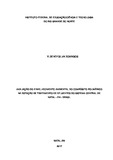Avaliação do envelhecimento ambiental do compósito polimérico na Estação de Tratamento de Efluentes do Sistema Central de Natal - RN - Brasil

Visualizar/
Data
2017-07-28Autor
Domingos, Yldeney Silva
http://lattes.cnpq.br/9413528434208043
Metadado
Mostrar registro completoResumo
The use of composites presents a structural alternative that provides mechanical
advantages when compared to more traditional building materials such as concrete
and steel. Polymer composites, when exposed to adverse conditions such as
ultraviolet radiation, high temperatures, oxidizing agents and excessive moisture,
result in changes in physical characteristics and in their mechanical behavior,
depending on the period of exposure and the conditions of service. Thus, the present
work presents an evaluation of the mechanical and physical behavior of the fiber glass
type E reinforced polymer composite (FGRP) when exposed to agents of
environmental aging at the effluent treatment plant of the Central System of Natal-RN,
also known as ETE do Baldo. The composite was made by the hand lay-up method
and the test bodies (TB) according to ASTM D3039-14 and ASTM D790-10 standards
for the uniaxial tensile and three-point bending tests, respectively, where these were
exposed for a period of 08 (eight) months, conditioned above and immersed in the
effluent. In addition, the physical-chemical characterization of the effluent was carried
out to evaluate the following parameters: pH, conductivity, sulfate, alkalinity, acidity,
sulfide and temperature, aiming at characterizing the effluent conditions in direct and
indirect contact with the composite. After the exposure period, tests were carried out
for morphological evaluation, evaluation of the structural integrity, evaluation of the
mechanical performance and of the characterization of the fracture of the polymer
composite, and thus a comparison was made between the mechanical characteristics
of the fracture of the polymer composite in the original state with that of the aged state
(post exposure in ETE). The polymer composite studied proved to be stable after the
aging period with little variation of mass and slight changes in its coloration. The
mechanical properties evaluated also did not have significant changes during the
studied period, thus showing that the FGRP presents the potential of being used in
aggressive environments such as in effluent treatment plants.



